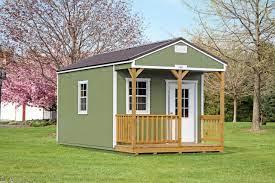Are Portable Cabins Suitable For Extreme Weather Conditions

Portable cabins are becoming a popular choice for various needs, from temporary housing to office spaces. However, one pressing question arises: are these cabins suitable for extreme weather conditions? In Missouri, where weather can range from scorching summers to freezing winters, ensuring the safety and comfort of portable cabins is critical. Let’s dive into this topic and explore how portable cabins perform in challenging climates.
Understanding Portable Cabins
Portable cabins are prefabricated structures designed for mobility and convenience. They are versatile and used in industries such as construction, education, healthcare, and even residential applications. Made from durable materials, portable cabins are engineered to withstand different environments. However, their ability to endure extreme weather depends on various factors, including construction quality, materials, and design.
Key Features That Enhance Weather Resistance
1. Material Quality
-
Insulated Panels: High-quality insulated panels help maintain interior temperature, making them suitable for both hot and cold climates.
-
Steel Frames: Many portable cabins are constructed with steel frames, offering excellent durability against high winds and heavy snow loads.
-
Weatherproof Exteriors: Materials such as treated wood, fiberglass, and metal coatings prevent moisture penetration and reduce wear and tear.
2. Structural Design
-
Reinforced Walls: Modern portable cabins feature reinforced walls to enhance stability.
-
Sloped Roofs: Sloped roofs ensure that rain and snow slide off, reducing the risk of damage.
-
Elevated Base: An elevated base protects against flooding during heavy rains or snowmelt.
3. Custom Add-Ons
-
Storm Shutters: Provide extra protection during hurricanes or strong storms.
-
Snow Guards: Prevent snow accumulation on the roof.
-
HVAC Systems: Advanced HVAC systems regulate temperatures effectively during extreme heat or cold.
Performance in Extreme Weather Conditions
Hot Climates
Missouri summers can be unforgiving, with temperatures often exceeding 90°F. Portable cabins equipped with:
-
Reflective Roof Coatings: Deflect sunlight to keep interiors cool.
-
Air Conditioning Units: Ensure comfort even in peak summer.
-
UV-Protected Windows: Minimize heat absorption.
Cold Climates
Winter in Missouri can bring temperatures below freezing. Key features for cold weather include:
-
High-Quality Insulation: Reduces heat loss.
-
Heating Systems: Keep interiors warm and functional.
-
Double-Glazed Windows: Prevent drafts and improve energy efficiency.
High Wind Speeds
Missouri’s tornado-prone regions demand cabins with:
-
Anchor Systems: Secure the cabin firmly to the ground.
-
Aerodynamic Designs: Minimize wind resistance.
-
Impact-Resistant Walls: Offer added safety against flying debris.
Heavy Rain and Snow
Portable cabins designed for wet climates feature:
-
Waterproof Seals: Prevent water from seeping in.
-
Drainage Systems: Ensure proper runoff during storms.
-
Anti-Corrosion Materials: Extend the cabin’s lifespan in damp conditions.
Benefits of Portable Cabins in Extreme Weather
Versatility
Portable cabins can be customized to meet specific climate needs, making them adaptable for various weather conditions.
Cost-Effective Solutions
Compared to traditional buildings, portable cabins provide weather resilience at a fraction of the cost.
Quick Installation
These structures can be installed quickly, providing immediate shelter in emergencies or extreme weather events.
Limitations to Consider
Despite their benefits, portable cabins may face certain challenges in extreme weather:
-
Weight Constraints: Lightweight designs may struggle against severe winds without proper anchoring.
-
Thermal Bridging: Poor construction can lead to heat transfer, reducing energy efficiency.
-
Maintenance Needs: Regular checks are necessary to ensure optimal performance in extreme conditions.
Tips for Enhancing Durability
-
Choose High-Quality Materials: Opt for cabins made with weather-resistant materials.
-
Invest in Insulation: Proper insulation is key for both heat and cold protection.
-
Regular Maintenance: Inspect and repair any wear and tear.
-
Customization: Add features like storm shutters or enhanced drainage systems.
-
Work with Experts: Partner with manufacturers who specialize in portable cabins for extreme weather.
FAQs About Portable Cabins and Weather Conditions
Q1. Can portable cabins handle snowstorms?
Yes, portable cabins designed with reinforced roofs and proper insulation can withstand snowstorms effectively.
Q2. Are portable cabins safe during tornadoes?
While no structure is entirely tornado proof, portable cabins with secure anchoring and impact resistant materials offer substantial protection.
Q3. How do portable cabins stay cool in the summer?
Features like reflective roof coatings, insulation, and air conditioning systems help maintain cool interiors during hot weather.
Q4. What maintenance is required for portable cabins in extreme climates?
Regular inspections, sealing of leaks, and checking HVAC systems ensure the cabin remains weather resistant.
Conclusion
Portable cabins are highly adaptable and can be tailored to withstand extreme weather conditions. With the right materials, design, and maintenance, these structures offer a practical and reliable solution for Missouri’s varied climate. Whether it’s summer heat, winter snow, or unpredictable storms, a well constructed portable cabin ensures safety and comfort.
- Information Technology
- Office Equipment and Supplies
- Cars and Trucks
- Persons
- Books and Authors
- Tutorials
- Art
- Causes
- Crafts
- Dance
- Drinks
- Film
- Fitness
- Food
- Spiele
- Gardening
- Health
- Startseite
- Literature
- Music
- Networking
- Andere
- Party
- Religion
- Shopping
- Sports
- Theater
- Wellness



